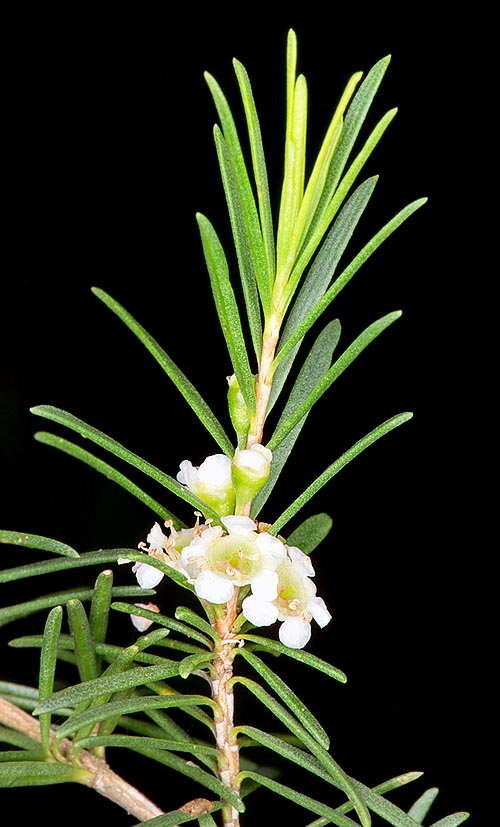Family : Myrtaceae

Text © Pietro Puccio

English translation by Mario Beltramini

Relative of myrtle but with rosemary leaves, Baeckea frutescens is a 1-6 m shrub native to South-East Asia and Australia, used by locals for infusions, with numerous medicinal virtues presently studied for a possible use in the official pharmacopoeia © G. Mazza
The species is native to Australia (New South Wales and Queensland), Borneo, Cambodia, China (Anhui, Fujian, Guangdong, Guangxi, Henan, Hong Kong, Hunan, Jiangsu, Jiangxi, Kin-Men, Macau, Ma-tsu-Pai-chúan, Shanghai and Zhejiang), Laos, Myanmar, Peninsular Malaysia, Philippines, Singapore, Sulawesi and Sumatra where lives along the coasts on sandy soils as well as in the prairies and bushes on hill and mountain slopes up to about 1000 m of altitude.
The genus is honoured to the Swedish physician Abraham Bäck (1713-1795); the specific Latin name “frutescens” = that tends to become shrubby, refers to the appearance of the plant.
Common names: dwarf mountain pine, false ru, shrubby baeckea, weeping coast myrtle (English); moreck ansai (Khmer); gang song (Chinese); djung rahab, junjung atap, udjung atap (Indonesian); chuchur atap, cucuran atap, da eng, rempah gunong (Malay); son hom, son naa, son saai (Thai); choi tren, choi xue thanh hao (Vietnamese).
The Baeckea frutescens L. (1753) is a shrub or a small evergreen tree, ramified, 1-6 m tall, even if it is normally kept lower, with trunk up to 10 cm of diameter with greyish brown, vertically fissured bark, tending to flake. The leaves, on an about 1 mm long petiole, are simple, opposite, grouped at the nodes, linear with pointed apex, 5-15 mm long and about 0,8 mm broad, grooved above, dotted by oileiferous glands below, of green or green-grey colour.
Solitary flowers at the axil of the leaves, bisexual, of 3-5 mm of diameter, campanulate calyx with 5 triangular lobes with pointed apex, 5 roundish unguiculate petals (petals with long narrow base similar to a stem), white, 1,5 mm long and 1-1,8 mm broad, and 5-13 stamina. The fruits are dehiscent capsules of 2-3 mm of diameter containing 6-8 tiny angular seeds.
It reproduces by seed, placed in surface in draining loam maintained constantly humid, with germination times of about 2 months, and by semi-woody cutting with heel.
Ornamental shrub cultivable in the gardens in tropical, subtropical and warm temperate climate zones, where it can resist to temperatures up to -6 °C, provided exceptional and short lasting, is also an excellent and appreciated subject for bonsai; all parts of the plant are particularly aromatic. Requires an exposition in full sun or slight shade and draining soils, even poor, with moderate waterings, but allowing the loam to dry up before giving water again.
The wood, hard and long lasting, is used in the fences and as fuel, the leaves and the flowers are utilized for preparing a herbal tea, but the best known and diffused use in the origin countries is that as medicinal plant.
All parts of the plant, but the roots, are variously utilized in the traditional medicine as antibacterial, antipyretic, diuretic, tonic, analgesic and in the gastrointestinal disorders, whilst the essential oil extracted from the leaves is used in the massages for relieving rheumatic pains. They have identified several bioactive compounds that are under study for a possible employment in the official pharmcopoeia.
Synonyms : Baeckea chinensis Gaertn. (1788); Cedrela rosmarinus Lour. (1790); Baeckea sinensis Gaertn. (1788); Neuhofia rosmarinifolia Stokes (1812); Baeckea cumingiana Schauer (1843); Baeckea ericoides Schltdl. (1846); Drosodendron rosmarinus (Lour.) M.Roem. (1846); Baeckea cochinchinensis Blume (1850); Baeckea sumatrana Blume (1850); Baeckea stenophylla F.Muell. (1858).
→ To appreciate the biodiversity within MYRTACEAE family please click here.
